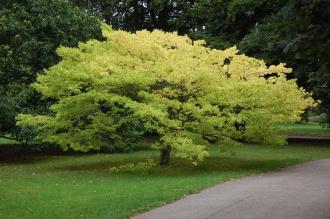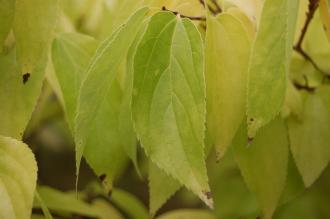
Celtis sinensis (21/09/2013, Kew Gardens, London)
Position: Full sun to partial shade
Flowering period: Spring
Soil: Moist, well drained
Eventual Height: 20m
Eventual Spread: 20m
Hardiness: 5a, 5b, 6a, 6b, 7a, 7b, 8a, 8b, 9a, 9b
Family: Cannabaceae
Celtis sinensis is a fast growing deciduous tree with a rounded, spreading habit. Its mid green leaves are ovate to ovate-lancelate with serrate, wavy margins, are asymmetric at their bases, up to 10cm long and 6cm broad. In autumn its leaves turn pale yellow. Its sliver gray bark is smooth when young becoming rough with age. Its green flowers are monoecious, the male appearing on slender drooping pedicels. Its orange fruit are a globose drupe, up to 8mm across and appear in autumn.

Celtis sinensis Leaf (21/09/2013, Kew Gardens, London)
Celtis sinensis, commonly known as the Chinese Hackberry or Japanese Hackberry, is native to China, Japan, Taiwan and Korea. This tree is considered a Class 3 pest in parts of Australia.
The etymological root of the binomial name Celtis is from the ancient Greek meaning ‘a tree with sweet fruit’. Sinensis is derived from the Latin meaning ‘from China’.
The landscape architect may find Celtis sinensis useful as an attractive medium sized tree with attractive autumn color. As this tree is tolerant of urban pollution it is also suitable as a street tree. Once established this tree is drought tolerant.
Ecologically, Celtis sinensis berries are eaten by some bird and mammal species.

Celtis sinensis Bark (21/09/2013, Kew Gardens, London)
Celtis sinensis prefers moist, deep, fertile, well-drained soils. It tolerates most pH of soil.
Celtis sinensis requires little maintenance.

